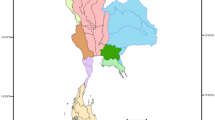Abstract
Incorporating climate change into water resource planning is crucial to ensuring sustainable growth and development. The aim of this study was to investigate how the proposed steps to incorporating climate change into project planning developed by USAID could be applied in practice using the town of Polokwane in northeastern South Africa as a case study. Two Regional Circulation Models (RCMs) and statistical downscaling from a range of General Circulation Models (GCMs) were used to produce a set of monthly climate scenarios for 2025 and 2050. These scenarios were used to estimate the impact on surface water runoff in the Olifants River catchment and the Letaba River catchment, and groundwater recharge in the Sand River Aquifer. The impact on the potential yields from the existing Flag Bashielo Dam and other proposed dams in the Olifants River catchment were determined using the Water Resources Yield Model (WRYM). The results of the analysis were discussed at a regional stakeholders workshop. The workshop participants concluded that the higher priority for now should be on water conservation and demand management (WCDM) and to consider a phased approach to developing additional storage capacity. The results of this study show that the six-stage process for incorporating climate change into resource planning can be applied in practice and that the potential threat of climate change can give emphasis to existing win–win approaches such as WCDM and phased implementation that should form part of any sustainable water resource planning approach.
Similar content being viewed by others
References
Christensen JH, Hewitson B, Busuioc A, Chen A, Gao X, Held I, Jones R, Kolli RK, Kwan WT, Laprise R, Magaña V, Mearns L, Guillermo C, Räisänen J, Rinke A, Sar A, Whetton P (2007) Regional climate projections. In: Solomon S, Qin D, Manning M, Chen Z, Marquis M, Averyt KB, Tignor M, Miller HL (eds) Climate change 2007: the physical science basis. Contribution of working group I to the fourth assessment report of the intergovernmental panel on climate change. Intergovernmental panel on climate change. Cambridge University Press, New York
Department of Water Affairs and Forestry (DWAF) (2004) National water resources stategy: first edition. http://www.dwaf.gov.za/Documents/Policies/NWRS/Default.htm. Cited August 27, 2009
Department of Water Affairs and Forestry (DWAF) (2006) Olifants River Water Resources Development Project (ORWRDP). Department of water affairs and forestry. http://www.dwaf.gov.za/Projects/olifant/index.htm. Cited January 5, 2006
De Wit M, Stankiewicz J (2006) Changes in surface water supply across Africa with predicted climate change. Science 311:1917–1921
Gildenhuys BC et al (2005) Infrastructure investment framework. Technical; analysis of service delivery options. Working Document. Report 1 of 2. Urban Institute, Washington
Government of RSA (2000) Initial national communication under the United Nations framework convention on climate change. October 2000. Government of the Republic of South Africa. http://unfccc.int/resource/docs/natc/zafnc01.pdf. Cited June 12 2006.
Hewitson BC, Crane RG (2006) Consensus between GCM climate change projections with empirical downscaling. Int J Climatol 26(10):1315–1337
Knight Piesold – Stewart Scott Joint Venture (KP-SS) (2005) Olifants river water resources development project: surface water resources: draft final report
Midgeley DC, Pitman WV, Middleton BJ (1994) Surface water resources of South Africa 1990: vol I: drainage region A,B: Limpopo-Olifants WRC Report 298/1.1/94
Sami K, Murray EC (1998) Guidelines for the evaluation of water resources for rural development with an emphasis on groundwater. WRC Report no. 677/1/98. Water Research Commission, Pretoria
Tadross M, Jack C, Hewitson B (2005) On RCM-based projections of climate changes in southern African summer climate. Geophys Res Lett 32(23):23713. doi:10.1029/2005GL024460
Tanner A, Timm TD (1995) Olifants-Sand transfer scheme: feasibility study report annex 4: hydrology
UN (2006) United nations department of economic and social affairs: Population division. http://esa.un.org/unpp/index.asp?panel=1. Cited March 5, 2006
United States Agency for International Development (USAID) (2006) Adapting to climate variability and change: a guidance manual for development planning prepared by status consulting for the USAID
Van Aardt CJ (2004) A projections of the South African population, 2001 to 2021. Bureau of Market Research, University of South Africa, Pretoria
WRI (2005) World resources: 2005: the wealth of the poor: managing ecosystems to fight poverty. World Resources Institute. www.wri.org
WSM (2000) Pietersburg geohydrological assessment: numerical modelling of the Sand River aquifer report 2108 submitted to Capricorn Municipality
Zack T, Charlton S (2003) Better off, but ... Beneficiaries’ perceptions of the government’s housing subsidy scheme urban institute occasional paper no 12
Author information
Authors and Affiliations
Corresponding author
Rights and permissions
About this article
Cite this article
Cullis, J., Strzepek, K., Tadross, M. et al. Incorporating climate change into water resources planning for the town of Polokwane, South Africa. Climatic Change 108, 437–456 (2011). https://doi.org/10.1007/s10584-010-9891-9
Received:
Accepted:
Published:
Issue Date:
DOI: https://doi.org/10.1007/s10584-010-9891-9




